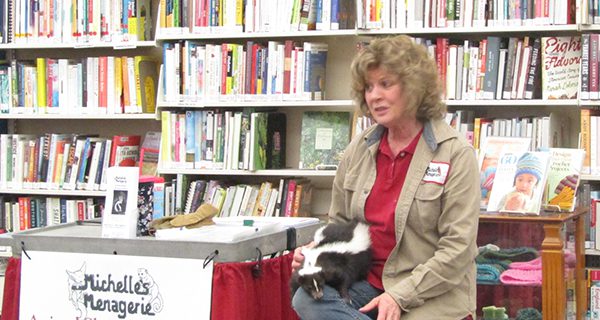[ccfic caption-text format="plaintext"]
By Amelia Tarallo
Hometown Weekly Staff
April vacation was in full swing when nearby towns were stricken with a series of rainstorms. Luckily for the children of Westwood, Michelle Debye and her Animal Menagerie were in town for a visit. On Thursday, April 18, Westwood's Islington Branch Library was filled with people. Children sat on the floor, ready to see a wonderful array of animals. "Raise your hand if you have a pet in your house," Michelle DeBye instructed her audience. Almost every hand went up. Michelle took a survey of each type of pet the children had. She followed-up with a second question: "If you could have any pet, what would it be?"
DeBye had brought a number of animals that possessed different qualities to protect themselves. “This show is about animal adaptions,” she explained.
The first animal Michelle brought out was a hedgehog. “Does anyone know what covers a mammal?” she asked, holding up Cooligan the hedgehog.
“Hair!” many of the children responded.
“Right!” Michelle shared a few interesting qualities about Cooligan and his fellow hedgehogs. Though they are adorable, hedgehogs don’t live very long, which can make having them as pets a very bittersweet experience. Michelle then asked her audience if they knew what Cooligan’s adaption was.
“His quills shoot out!” one girl exclaimed.
“No,” Michelle answered. She then showed the audience Cooligan’s belly. “Cooligan has a special muscle on his belly that lets him pull his quills over his body,” Michelle said, gesturing to the hedgehog.
The next animal Michelle brought out was Chachi the Chinchilla. Like other chinchillas, Chachi was covered in the fluffiest of gray fur. For chinchillas, this thick fur is a life-saver in dire moments. If a predator is trying to hunt them, chinchillas will run away as fast as they can. If the predator catches up with them, they will try to pick the chinchilla up. However, the chinchilla’s thick coat covers its skin so thoroughly that the predator may only have their fur. This leaves the chinchilla with a great escape. “It leaves that hunting animal with a mouth full of fur,” said Michelle. The chinchilla’s coat will regrow in time, leaving them just as fluffy as before.
Adora was an unexpected surprise for the children and their parents. Like the previous two animals, Adora was a pet, but not one most parents would want in their house. Adora was a skunk. Unlike what any wild skunk would do, Adora curled up on Michelle’s lap. “Adora was born on a farm,” Michelle explained. Like other skunks, Adora has tiny ears and very bad eyesight. “What’s the first thing a scared skunk is going to do?” Michelle asked her audience.
“Spray!” most of the children said. Michelle shook her head.
“That’s the last thing they do,” she answered. Michelle explained that scared skunks first hunch their backs and then make a terrifying hissing noise to scare off predators. Then, they will try to run away. Then, and only then, will a skunk spray a predator as a last resort. Adora the friendly skunk was raised to be Michelle’s pet and no longer had the ability to spray the typical skunk smell used for defense. As a pet, she no longer needs it.
Michelle moved on from the mammals of the presentation and began focusing on birds. “This is the tiniest bird I have,” Michelle began, showing her audience Rainbow, a small finch. Rainbow enjoyed the presentation from the comfort of his carrier, bopping his head around as Michelle had the kids take a stretching break. The next bird was Paradise, a beautiful parrot.
Michelle shared a story from a time when she had a very talkative parrot. The parrot would copy certain phrases, including one that most parents have to tell their children every night: “Do your homework.” Poor Patrick, Michelle’s son, would be harangued about his schoolwork by both his mother and his pet bird - hopefully, it made him a great student.
One of the last animals Michelle brought out was Teeny Tiny Timothy Tarantula. “I love an animal friend who gets rid of ticks and mosquitos,” said Michelle, telling the audience about the helpful qualities of this giant spider. ”What do you think his adaption is?” Michelle asked. The kids gave many guesses: his venom, his legs, his web.
But no one guessed his fur.
“His bite hurts, but you won’t even get sick from it,” Michelle explained. His fur, however, comes off when he rubs his little arms and legs. The fur flies into an attacker's nose and makes them itchy and sneeze. For such a big spider, it seems strange that its biggest defense is so miniscule.
At the end of the presentation, the children of the audience were invited to pet a snake Michelle had brought with her.
The presentation gave many of the kids and their parents great new ideas for pets they may want to add to their homes. Even more importantly, though, Michelle’s Animal Menagerie taught the children and parents all about some very cool animal adaptions.






















